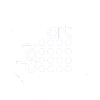This month dot-art speaks to artist Ali Barker.
Ali Barker creates visual representations of music and sound in colour, inspired by her experiences of the phenomenon of sound-colour synaesthesia. When Ali listens to music, she perceives notes of the musical scale as specific colours, expressing these through abstract paintings. Ali is also an orchestral musician in her spare time, playing violin and viola. The music that she performs inspires some of her paintings; other works are inspired by the wide range of music she listens to, or by music chosen by a client for a commission.
Ali often works with patterns and geometric forms, creating works derived from translations of the written music or analysis of recorded sounds. Other paintings are expressive synaesthetic responses, made by directly applying the colours to the paper or canvas while listening to a specific piece of music, or a combination of these styles.
Ali completed her MA in Fine Art in 2019, with a body of work focusing on the relationship between the orchestra and the soloist in a concerto, highlighting the complexity of music but extracting key themes from the musical structure.
Ali is also interested in depicting the urban skyline as colourful cityscapes; her ‘Liverpool Composition’ & ‘Wirral Composition’ mural designs won Merseytravel’s ‘Design a New Skyline’ competition and are public artworks on display inside the Birkenhead Tunnel.

Can you describe your style?
Colourful abstract paintings – some are in a loose, expressive style, others are geometric patterns. I also consider them to be ‘translational’, because of their inspiration and my processes.
Which medium do you work with and what do you like about it specifically?
I mainly work with acrylic paint on canvas, wooden panels, or paper. I like the quick drying time so that I can build up layers easily. I usually work with the same brand of paint which provides me with the range of bright colours that are specific to my practice, sometimes adding acrylic mediums to create matte or gloss effects or to increase their transparency.

Can you talk us through your process? Do you begin with a sketch, or do you just go straight in? How long do you spend on one piece? How do you know when it is finished?
It varies, depending on the style of work I am creating. Gestural, expressive works tend to be more spontaneous and the works themselves can be completed in a day, although there is a lot of preparation work in advance.
Geometric works start with listening, selecting and extracting excerpts or themes from music, then these are translated and developed into drawings, plans, and test pieces.
Once I feel the composition is right the plan is scaled up and drawn onto the canvas, then this is painted in sections over several weeks, or even months. In both styles of work, I draw on my instinctive feelings to decide when the composition is resolved.
When did you begin your career in art?
I left my previous career in 2014 to focus on my artwork, although I have been drawing and making work throughout my life. I completed my practice-based MA in Fine Art in 2019, which enabled me to undertake an in-depth exploration of my practice.
Who or what inspires your art?
My experiences of playing and listening to music and my personal perceptions are the inspiration and motivation for my work. I experience sound-colour synaesthesia – when listening to music, I perceive notes of the musical scale as specific colours. Synaesthetic perceptions are difficult to describe in words; my experiences are fleeting perceptions of bright colours in my mind’s eye.
Why is art and creativity important to you?
Creating my artwork is an expression of my personal experiences, and I enjoy the physical process of making things.
What do you gain from being a member with dot-art?
Opportunities for selling limited-edition prints and original paintings through the gallery and my portfolio page on the dot-art website, plus opportunities for commissions, art rentals, and networking with other artists.
What does it mean to be an artist in the Liverpool City Region?
It’s great to have a wide range of exhibitions and events to visit on the doorstep – from small, artist-led shows to blockbuster exhibitions at the Tate or the Walker Art Gallery, and anything and everything in between. There are also many possibilities for showing your work and for networking or even collaborating with other artists in the area.
What are you working on at the moment?
I’m developing some new geometric paintings, including some that interweave my visual expression of two or more musical themes.
What was the best advice given to you as an artist?
Make work that interests you: what you make, why you make it, or preferably both. It is very hard to sustain your practice if you are not really interested in what you do, as the work won’t come from within you.
Discover more of Ali Barker’s work on our online shop!


